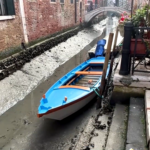
Venice canals start to run dry, leaving gondolas stranded

Italy is facing another year of severe drought, with the Alps receiving less than half of the expected snowfall this winter and water levels in the north of the country falling to record lows, according to science and environmental groups.
In Venice, a low-lying city typically more concerned with flooding, the historic canal network has been hit by unusually low tides — reducing some canals to little more than a muddy ditch.
The low water levels are making it difficult for gondolas, water taxis and ambulances to navigate the famous canals — affecting vital services in the city. Throngs of tourists have also been disappointed by the less-than picturesque views, and the annual carnival has also been disrupted.
Dry weather is unusual in Venice in February. The problems are being blamed on a combination of factors, including a lack of rain, a high-pressure system, a full moon and sea currents.
Italy declared a state emergency last summer after facing its worst drought in 70 years, while Europe saw its hottest summer on record. The Po, Italy’s longest river, has all but dried up in some places and currently has 61 per cent less water than normal at this time of year, according to the Legambiente environmental group.
Last summer (2022), drought effectively shut many Flemish waterways, including places such as Ghent, as a result of lowering water levels in the region.
Lake Garda in northern Italy has also seen its water levels fall to record lows, making it possible to reach the small island of San Biagio on foot via an exposed pathway.
Watch the water.
— Jabobfre likke (@541patriot) February 11, 2023
Venice. pic.twitter.com/Y2oAx9n0Wm
Italian daily Corriere della Sera spoke with Massimiliano Pasqui, a climate expert with the Italian scientific research institute CNR.
“We are in a water deficit situation that has been building up since the winter of 2020-2021,” says Pasqui. “We need to recover 500 millimetres in the north-western regions: we need 50 days of rain.”
Forecasts are predicting some relief in the form of precipitation and snow in the Alps in the coming days.
How scary to see the canals in Venice drying up
— Kat#drought #globalweather pic.twitter.com/ygRhpjzUXU
(@KatDly) February 20, 2023
Images taken by Nasa in August 2022 also showed the dramatic decline in the water level of Lake Mead – the largest reservoir in the United States. According to the NASA Earth observatory, water levels in Lake Mead are continuing a 22-year downward trend and stand at their lowest since April 1937, when the reservoir was still being filled for the first time.
The post Venice canals start to run dry, leaving gondolas stranded appeared first on Marine Industry News.

